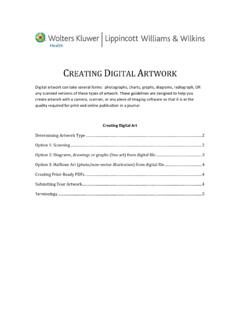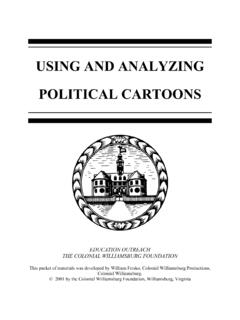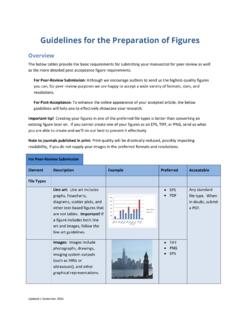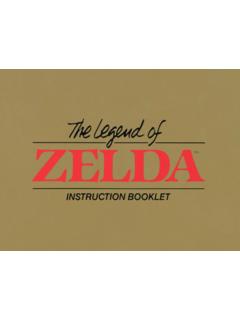Transcription of How to analyze an artwork: a step-by-step guide
1 Article source: COPYRIGHT NOTE: This article is owned and published by the Student Art guide . It may be printed and used in a classroom situation free of charge. To share this material with others, please link to the original document: Copying, sharing, uploading or distributing this article in any other way is not permitted. How to analyze an artwork : a step-by-step guide This article has been written for high school art students who are working upon a critical study of art, sketchbook annotation or an essay-based artist study. It contains a list of questions to guide students through the process of analyzing visual material of any kind, including drawing, painting, mixed media, graphic design, sculpture, printmaking, architecture, photography, textiles, fashion and so on (the word artwork in this article is all-encompassing).
2 The questions include a wide range of specialist art terms, prompting students to use subject-specific vocabulary in their responses. It combines advice from art analysis textbooks as well as from high school art teachers who have first-hand experience teaching these concepts to students. Why do we study art? Almost all high school art students carry out critical analysis of artist work, in conjunction with creating practical work. Looking critically at the work of others allows students to understand compositional devices and then explore these in their own art. This is one of the best ways for students to learn. Instructors who assign formal analyses want you to look and look carefully. Think of the object as a series of decisions that an artist made.
3 Your job is to figure out and describe, explain, and interpret those decisions and why the artist may have made them. The Writing Center, University of North Carolina at Chapel Hill 10 Article source: Art analysis tips I like this or I don t like this without any further explanation or justification is not analysis. Personal opinions must be supported with explanation, evidence or justification. Analysis of artwork does not mean description of artwork . To gain high marks, students must move beyond stating the obvious and add perceptive, personal insight. Students should demonstrate higher order thinking the ability to analyse, evaluate and synthesize information and ideas. For example, if color has been used to create strong contrasts in certain areas of an artwork , students might follow this observation with a thoughtful assumption about why this is the case perhaps a deliberate attempt by the artist to draw attention to a focal point, helping to convey thematic ideas.
4 Although description is an important part of a formal analysis, description is not enough on its own. You must introduce and contextualize your descriptions of the formal elements of the work so the reader understands how each element influences the work s overall effect on the viewer. Sylvan Barnet, A Short guide to Writing About Art2 Cover a range of different visual elements and design principles. It is common for students to become experts at writing about one or two elements of composition, while neglecting everything else for example, only focusing upon the use of color in every artwork studied. This results in a narrow, repetitive and incomplete analysis of the artwork . Students should ensure that they cover a wide range of art elements and design principles, as well as address context and meaning, where required.
5 The questions below are designed to ensure that students cover a broad range of relevant topics within their analysis. Article source: Write alongside the artwork discussed. In almost all cases, written analysis should be presented alongside the work discussed, so that it is clear which artwork comments refer to. This makes it easier for examiners to follow and evaluate the writing. Support writing with visual analysis. It is almost always helpful for high school students to support written material with sketches, drawings and diagrams that help the student understand and analyse the piece of art. This might include composition sketches; diagrams showing the primary structure of an artwork ; detailed enlargements of small sections; experiments imitating use of media or technique; or illustrations overlaid with arrows showing leading lines and so on.
6 Visual investigation of this sort plays an important role in many artist studies. Making sketches or drawings from works of art is the traditional, centuries-old way that artists have learned from each other. In doing this, you will engage with a work and an artist s approach even if you previously knew nothing about it. If possible do this whenever you can, not from a postcard, the internet or a picture in a book, but from the actual work itself. This is useful because it forces you to look closely at the work and to consider elements you might not have noticed before. Susie Hodge, How to Look at Art7 Finally, when writing about art, students should communicate with clarity; demonstrate subject-specific knowledge; use correct terminology; generate personal responses; and reference all content and ideas sourced from others.
7 This is explained in more detail in our article about high school sketchbooks: Article source: What should students write about? Although each aspect of composition is treated separately in the questions below, students should consider the relationship between visual elements (line, shape, form, value/tone, color/hue, texture/surface, space) and how these interact to form design principles (such as unity, variety, emphasis, dominance, balance, symmetry, harmony, movement, contrast, rhythm, pattern, scale, proportion) to communicate meaning. As complex as works of art typically are, there are really only three general categories of statements one can make about them. A statement addresses form, content or context (or their various interrelations).
8 Dr. Robert J. Belton, Art History: A Preliminary Handbook, The University of British Columbia5 ..a formal analysis the result of looking closely is an analysis of the form that the artist produces; that is, an analysis of the work of art, which is made up of such things as line, shape, color, texture, mass, composition. These things give the stone or canvas its form, its expression, its content, its meaning. Sylvan Barnet, A Short guide to Writing About Art2 This video by Dr. Beth Harris, Dr. Steven Zucker and Dr. Naraelle Hohensee provides an excellent example of how to analyse a piece of art (it is important to note that this video is an example of formal analysis and doesn t include contextual analysis, which is also required by many high school art examination boards, in addition to the formal analysis illustrated).
9 Article source: Composition analysis: a list of questions The questions below are designed to facilitate direct engagement with an artwork and to encourage a breadth and depth of understanding of the artwork studied. They are intended to prompt higher order thinking and to help students arrive at well-reasoned analysis. It is not expected that students answer every question (doing so would result in responses that are excessively long, repetitious or formulaic); rather, students should focus upon areas that are most helpful and relevant for the artwork studied (for example, some questions are appropriate for analyzing a painting, but not a sculpture). The words provided as examples are intended to help students think about appropriate vocabulary to use when discussing a particular topic.
10 Definitions of more complex words have been provided. Students should not attempt to copy out questions and then answer them; rather the questions should be considered a starting point for writing bullet pointed annotation or sentences in paragraph form. CONTENT, CONTEXT AND MEANING Subject matter / themes / issues / narratives / stories / ideas There can be different, competing, and contradictory interpretations of the same artwork . An artwork is not necessarily about what the artist wanted it to be about. Terry Barrett, Criticizing Art: Understanding the Contemporary6 Our interest in the painting grows only when we forget its title and take an interest in the things that it does not Fran oise Barbe-Gall, How to Look at a Painting8 Article source: Does the artwork fall within an established genre ( historical; mythical; religious; portraiture; landscape; still life; fantasy; architectural)?







